Instar Theory ⋆˚࿔
the plague, flower farming, and the inherent evolutionary capacity to change or stay the same
Dear Reader, I’m sorry. This is a long one.
It’s ambient 65° winter here in Northern California. Southern California is on fire. The United States is actively funding a genocide with an 8 Billion Dollar Arms Deal as the year comes to a close. Can you fathom 8 Billion dollars, for anything else? The carbon emissions from war can be directly linked to a changing climate, and the U.S. Department of Defense puts its own emissions at 51 million metric tons of carbon dioxide equivalent in fiscal year 2021, which was roughly the same as the emissions produced by Sweden. Every year is the hottest year on record. There is much work to do, but most days all I can muster is a few pots here and there, design work that will pay my bills, and to feed myself. Are you working hard? What are you working hard, towards? Are you feeling anxious? How are you handling “the news”?
I can’t seem to focus on anything, my attention gets caught in seven directions and I end up doing one thing very, very poorly. One thing I am doing poorly is writing. I have a lot of ideas, and a lot of things I want to share, but I get caught up in the performance of it all, and the inherent ego of “writing”, and the evils of looking at a screen.
There are very real and very serious things happening in our life-time, that we may or may not have the capacity to change. What I’ve thinking about for this period of time we are all living in —-referred to as the Anthropocene or more specifically by writer Adrienne Maree Brown: a period in which we might see the Collapse of the Empire1. Imperialistic, warmongering, resource-hoarding, bloodthirsty capitalism is destroying the earth and the fabric of our society and will inevitably lead to a total systems collapse. I don’t think this is a fringe-theory anymore.
When I think of a “systems” collapse — I think of the wildfires in Nevada of 2020/2021, the wildfires now, the colorado river drying up, disease, pandemic, and I think of the grasshopper plague of 24’ in Paonia.
In the summer I was farming organic cut-flowers in the paradise of rural Colorado. From March to October I would wake up in the dark from my yurt and make my way to the farm as the sun crested over the mountains, to cut, collect, and store dozens of varieties of flowers. Groggy but anticipating the beauty of crisp summer mornings in view of Mt. Lamborn, dew-covered flowers, the bugs & birds singing.
Sidenote: Did you know that Cobb Mtn. Ca and Paonia, Colorado share an almost direct longitude? A meridian line straddling these distinctly different places? Only a dozen or so degrees apart…
A lot of orchards, vegetable and flower farmers from the prolifically abundant North Fork Valley struggled with the Plague this past season. In maybe a morbid way, I became hyper-fixated with the sheer quantity, capacity for destruction, and mechanical nature of the harbingers of death: the Grasshopper. I documented the shit out of them. I took gruesome videos of praying mantis’s ripping their abdomens open. I squished them with my workbooks. I cut their heads off with scissors.
Others have theories of this plague beginning in 2023, a record breaking year for precipitation in Colorado, potentially creating the perfect ecosystem for the GRASSHOPPER. Early 2023 broods initially affected many farmers in the valley, but as the 23’ cycle laid countless eggs in the fertile, wet ground, overwintering and undisturbed… the real apocalypse began in the spring of the following year in 2024.
Almost all of my friends, coworkers, acquaintances or neighbors in Paonia were affected by this. Everyone there grows food or knows someone who grows food. Living in the North Fork Valley means someone you know is a farmer, gardener, hobbyist with growing plants of some kind, or lives on a farm, vineyard, an orchard / a field / a weed op etc. Most people live in the Abundant Valley because of it’s direct link to organic agriculture…
I cannot explain or articulate, or capture the ramifications of the grasshopper plague on this area. The spirit of the valley was shaken. You had to be there, talking to the demoralized farmers at the market. You had to be walking through the tall grass in June, feel the plasticy, hard-bodied creature the size of a baby carrot with many hooked legs jumps with a THWACK onto your body, or next to your body, in hundreds and hundreds of permutations, rippling through the ground in a cloud and onto trees, fence-posts, fields. Watching your every move, Grasshoppers have compound eyes and extremely well developed sight compared to other insects, and you could directly watch their eyes, watching You back.
Anywhere you walked or stood, there would be Grasshoppers plastering the road, riding on your shoulder when you weren’t looking, grasshoppers in your house, in your shoes, grasshoppers in a glass of water set on the ground, in your coffee… grasshoppers eating your melon starts, your cucumbers whole, your peach trees, your weeds, your dye plants, your hundreds and hundreds of dahlias…
So much destruction occurred, that at one point in the season, we started putting plastic mesh bags over the dahlia heads by HAND every other day to prevent the grasshoppers from eating through the bulbs overnight. Eventually, they started eating through the plastic to get to the flower, anyway. The decimation was pure, total for some varieties of plants and felt final in it’s arbitration.
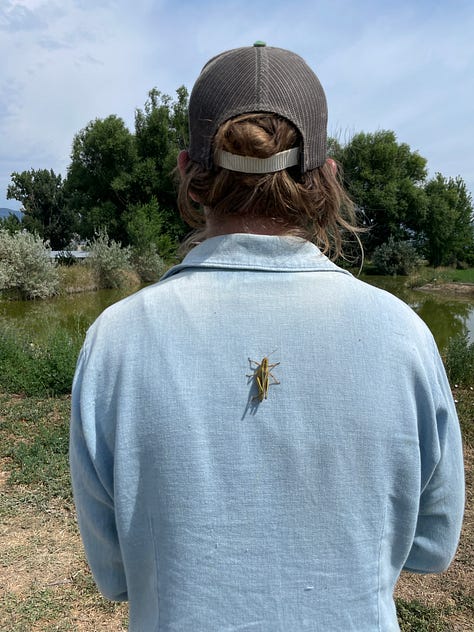
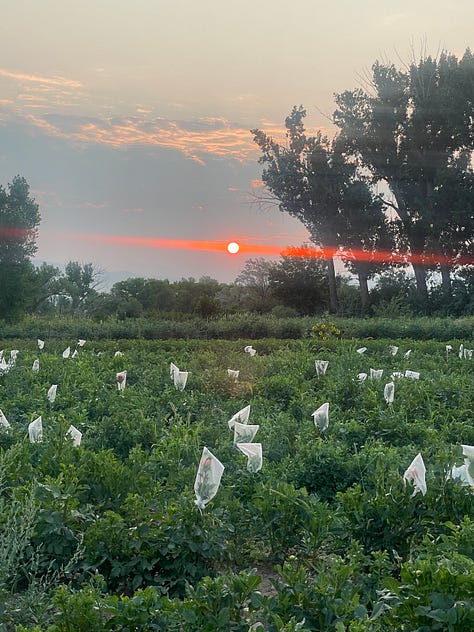
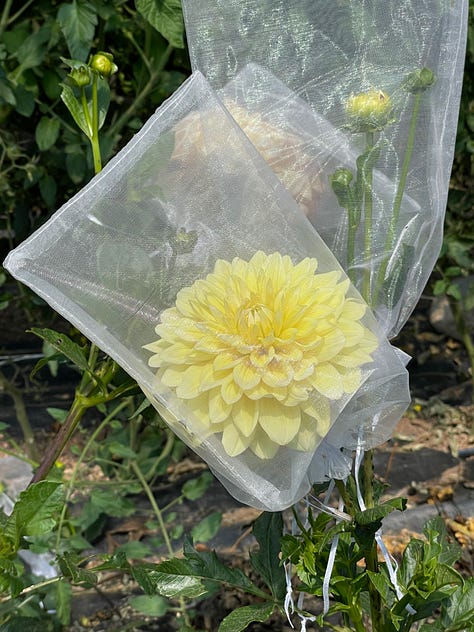
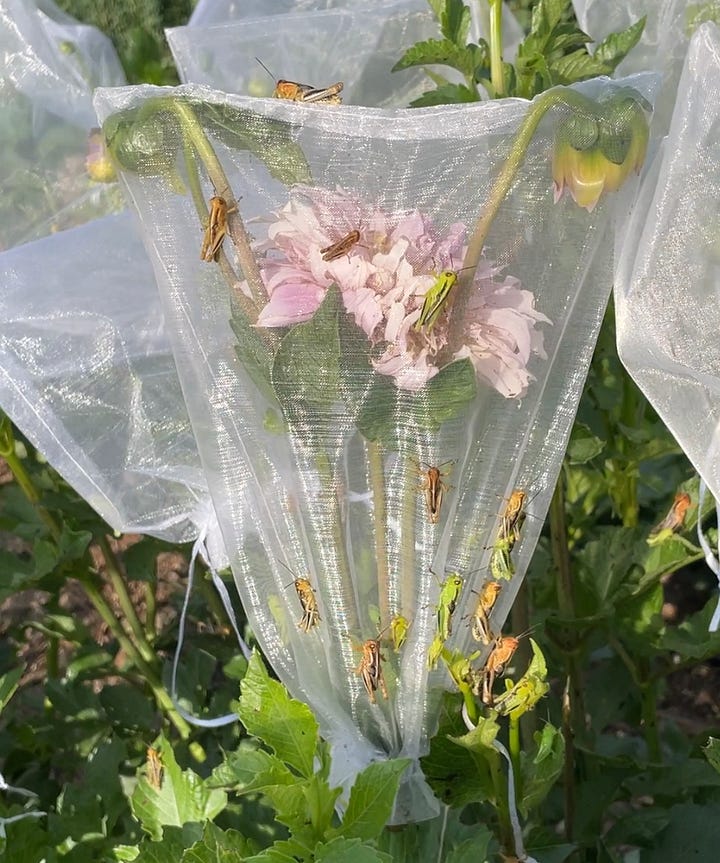
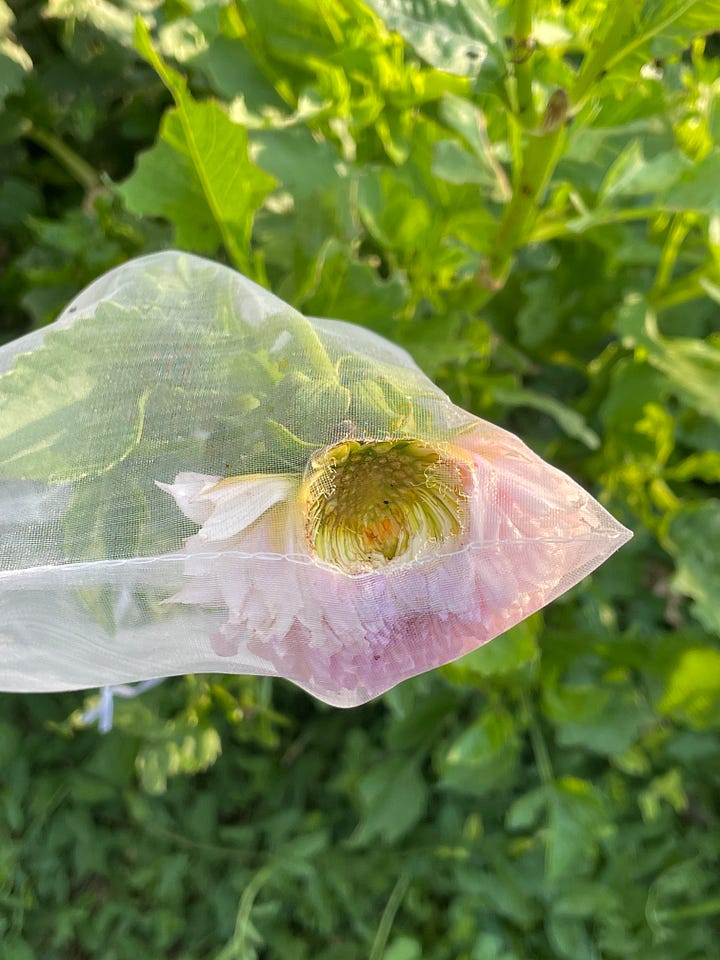
Grasshoppers (superfamily Acridoidea) are the most diverse group within the Orthoptera, with about 8,000 current species. Their bodies make me think of carcinisation, or the phenomenon in which different species evolve in to crab-like forms over many many years. Crabs, and maybe grasshoppers, are just the perfect form a species must take for survival through space-time on this earth.
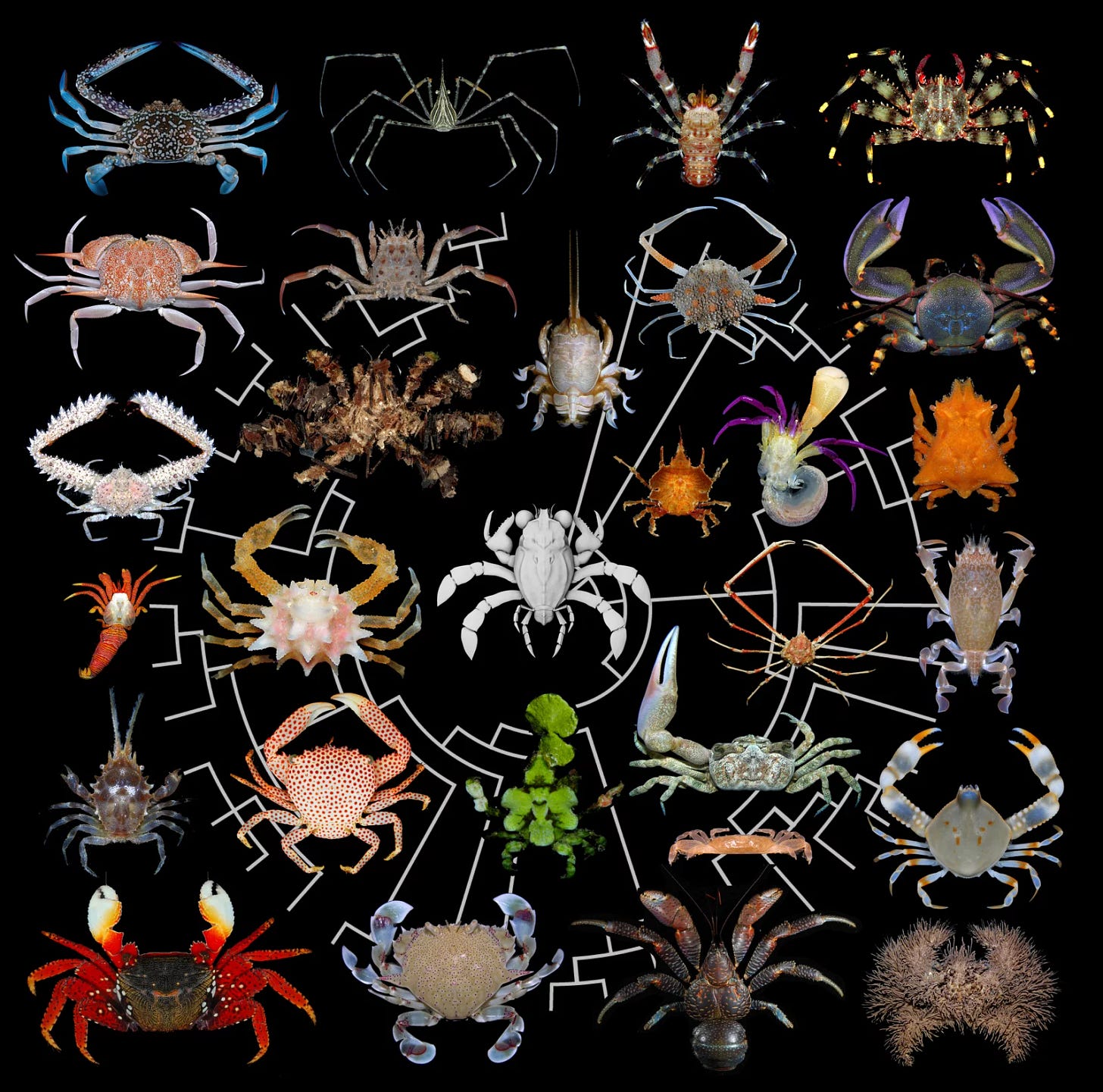
.
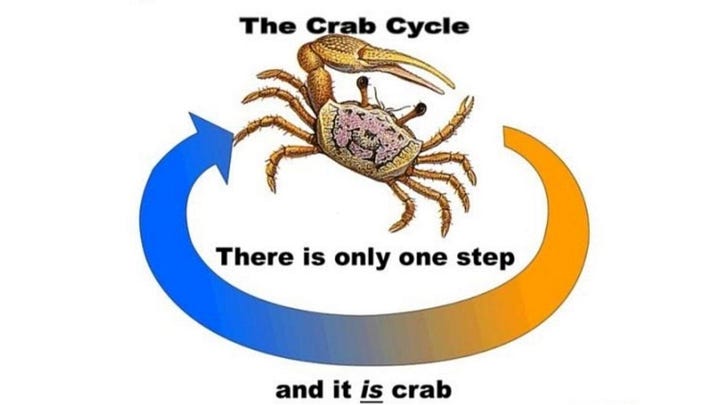
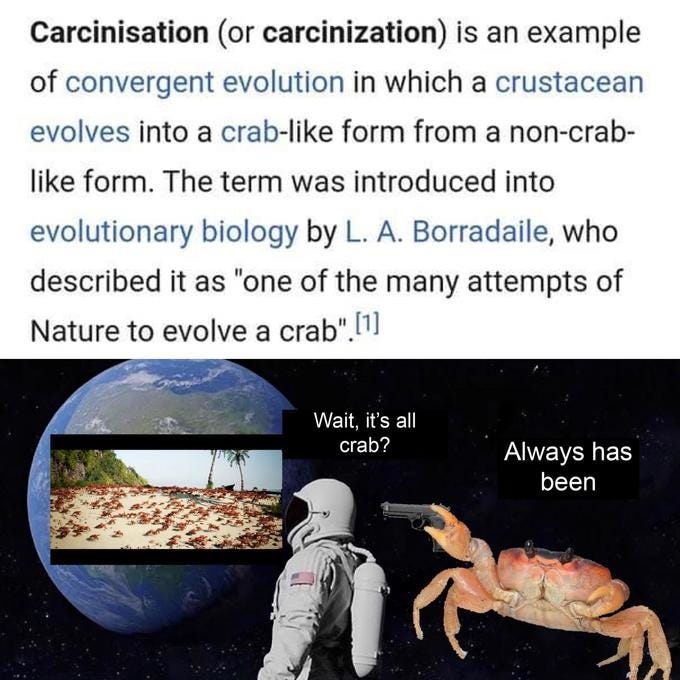
Chris calls grasshoppers “super soldiers”, the perfect evolutionary creature.. much like a crab… it seems like grasshoppers have not evolved since the mid to late Cenozoic Era (~65 million years ago to the present).. Now think about how the modern “human” evolved only 200,000 years to the present. Who’s winning in God’s eye as the best fitted creature for Earth? Grasshoppers and crabs don’t even have to change at all to survive. Us on the other hand… We are burning down the planet as I write this.
Grasshoppers have many special abilities. They camouflage to their surroundings, they can fly, they have hard armoured bodies, and they eat 10 times their weight in plant-matter in minutes. They also can directly, physically change form, much like a caterpillar into a butterfly, from a grasshopper to a Locust by shedding an exoskeleton to assume a new form. This phase of change is known scientifically as an “instar”.An instar2 is defined as the period between two apolyses and begins when the insect first becomes detached from its old skin. Some grasshoppers have a stage, or an instar, where they become locusts depending on the right conditions. Locust swarms are terrifying, biblical. The 1st harbinger of doom, Pestilence in reference to the 4 horsemen of the apocalypse. So how does a “solitary” green grasshopper minding it’s business decide to shapeshift into a larger, terrifying group of Locusts that can wipe out the food supply of entire countries?
Grasshoppers are usually solitary, but in conditions of drought followed by rapid vegetation growth, they experience a blast of serotonin. They become gregarious, breed abundantly, and whip into a migratory swarm in search of grub: Locusta. Like participants at a feast day, they too become excited with the prospect of food and drink in large numbers.
I love that word, “Gregarious” to describe a frenzied grasshopper. I started using it in the day—to-day. All locusts, at some point, were grasshoppers. But not all grasshoppers can be locusts. The step where a grasshopper morphs into a locust, can be described as an instar. I have all these quotes pulled from scientific research on these insects.. and yet I still can’t exactly describe… WTF is an instar…. I keep trying to explain my fascination with this phase and people get confused. To be frank, I’m kind of confused on the matter also. It’s a cycle. It’s a phase. It’s an in-between place. It’s the change that occurs before you are something else. It’s a shedding. It’s a molting. Its….. It seems like an insect, can be something in stasis and then due to environmental factors, or time, or “choice?”, it can dramatically change all features in minutes3.
“To determine if a bug is going through an instar, scientists or observers look for physical changes like increased body size, noticeable shedding of the exoskeleton (molting), alterations in coloration or markings, and sometimes changes in the development of specific body parts like wings between each molt, which marks the transition to a new instar stage; essentially, the bug will appear larger and may have slightly different features compared to the previous instar.”
I am not an entomologist. Learning about grasshoppers and researching them was a direct way for me to have some control in the matter of losing my livelihood, losing my plants, losing my flowers, and potentially something even more broad and far-reaching with the destruction that the plague and a rapidly changing climate brings. It was a coping mechanism, for these cataclysm events with happen with much more frequency, know that You have to be moldable, changing with the wind, like a river in flux, to the new challenges humanity is facing by the day. And we probably should be eating more bugs.
I started wondering if I can attribute birthdays, or disassociations from previous versions of myself, or times where I continue to move or age or phase into different lifestyles (—different communities, different haircuts, different passions-) as periods of metaphysical metamorphosis: i.e. human instars. Even a complete solar return could be categorized as an instar. Why not? I have shed many selves and versions, stripped down to the core by various experiences, only to emerge anew. If one wanted to apply critical theories of gender, or studies via psychedelic research on the brain to conceptualize a human instar, it only lines up. Anyone can change radically and at any time. Maybe it’s antithetical to the natural order of things to stay the same. (not in the case of crabs, though)




Maybe all it takes is the perfect environment, to brush up against others like you, to aggravate and trigger the new form — the New Body — to break open the old skin and rebirth a new, stronger, more capable and adept being. Maybe, in an act of survival in the current social and physical realm, we have to morph. We have to change, as a collective, into something completely else, with a harder enduring shell.
That might be a little much, but that’s my Instar theory. After all this, I now think of the humble but powerful grasshopper as a guide for Being.

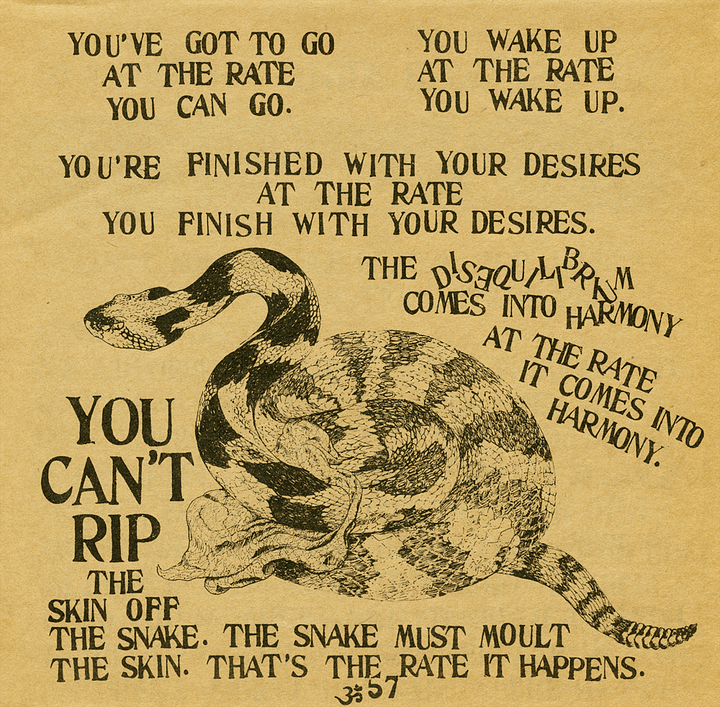
_
Mid-season, I was having grasshopper nightmares. I often felt enraged, hopeless, and ill at the sight of the bugs. The work we were doing on the farm felt fruitless, felt sisisphean. So many flowers eaten, so many vegetables destroyed. It felt like the future would be full of drought, pestilence, plague and war. I remember going to a “herbal allies of the summer season” where I was gifted a large quantity of dried Mugwort, which I was told was a magical, healing, intuitive plant. I had no experience with the plant besides being 18 once and trying to smoke dried old mugwort in an attempt to lucid dream. I don’t remember it working then. But when I drank some of this freshly dried mugwort in a tea, alone, late in the hot night in the privacy of my yurt—
I remember resting my head on my pillow, and within seconds visualizing a scene. I was conscious, but having a vivid thought / memory / premonition / lucid dream ? that entirely captured me. It played out as follows:
I am at the beach. The sun is setting in ambient color.. pinkish purple skies and tides pull in. My body is lying on the sand but I am watching from above, disassociated from the form on the beach. A large shadow comes into view… mechanically walking from the misty outskirts towards me. One leg, moving, one leg, forward. It’s a giant grasshopper the size of a car. It makes its way over to me, slowly, like a wind-up toy. Like grasshoppers do when they are not in a gregarious frenzy. Methodical, robotic. I am completely still on the beach, unmoving with baited breath—
The grasshopper arrives to my body, and begins to meticulously crawl on top of me, primed for taking the first bite of my flesh like I had seen them do to thousands of flowers. It sits there, pinning me down with 6 spiny legs, contemplating my human form with it’s alien eyes… I don’t move.
It doesn’t eat me. I wake up. I don’t feel angry anymore.
I hope this long rambling essay finds you
curious about our collective future.
-S
I’m collecting mailing info for a mail service for my paid subscribers! Please fill this out. If you are interested in my mail service consider financially supporting this publication.
How to Survive the End of the World is an excellent podcast about learning from apocalypse with grace and curiosity, by writer/facilitator Adrienne Maree Brown and Autumn Brown. Adrienne also has a podcast that goes chapter by chapter through Octavia E. Butlers Parable of the Sower thats really worth listening right now.
The champion of molting, and record-keeper of most instars is the fire brat insect (new DJ name?) with 60 MOLTS recorded!!!!
I used to watch my older sisters play Pokemon Yellow for hours and hours and hours and it’s funny to reference the gameboy music as the background for how I am imagining going through a human instar.


















